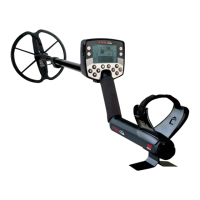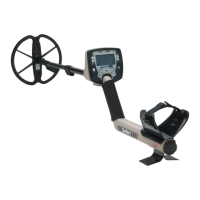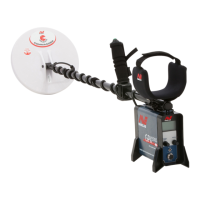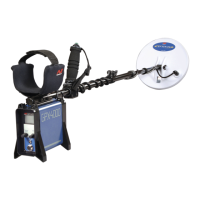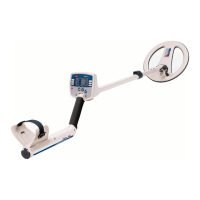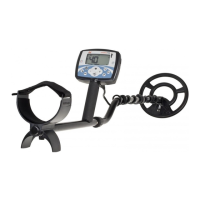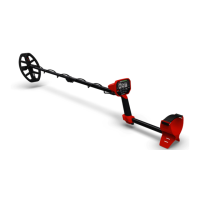Detector Sounds
Turn the detector on. The constant background ‘hum’ produced by the detector is
called the Threshold (page 23). Variations in the Threshold allow you to hear very
small and deep targets. It is also used to help distinguish between desired and
undesired targets.
The detector may also produce false signals (Noise) when not over the ground or
with the coil held motionless. These may not be target signals, but surrounding
electromagnetic interference (EMI). You can minimize false signals by performing a
Noise Cancel (page 20), performing a Ground Balance (page 22), or by reducing
the Sensitivity (page 21) of the detector. It is generally better to try to reduce false
signals by adjusting Noise Cancel and Ground Balance before resorting to reducing
the Sensitivity.
Sweep the coil across the targets one at a time. Observe the Detect screen and
listen to the sounds of the detector as it passes over each object. The Detect screen
and audio response will give you detailed information about the Target ID.
An audio signal is the sound produced by the detector when a target is detected
and not ‘rejected’. Large targets or targets close to the ground surface emit louder
signals.
When a ‘rejected’ target is detected, the Threshold ‘blanks’ (becomes silent),
indicating that a target is located underneath the coil, but has been rejected by the
Discrimination Pattern (Figure 43). Blanking is a useful way of distinguishing between
desired and undesired targets.
Figure 43 – Detector sounds
Very large objects close to the coil may overload the detector electronics. When
this happens, the detector displays an overload message and emits a fading
sound, which repeats until the coil is moved away from the source of the overload.
Overloading is not harmful to the electronics of the detector.
It is best to operate the detector only when outdoors and away from sources of
electromagnetic interference (EMI) such as power lines and phone towers. These
sources may cause the detector to perform erratically, giving false signals and
causing inaccurate target ID. There are also many metallic objects inside a house,
such as nails in the oor, reinforcing in the walls, televisions and other household
appliances, that might interfere with or overload the electronics of the detector.
It is important to understand the sounds produced when you make a valid or
invalid button press. You will usually encounter these sounds while adjusting
settings via the main menu. A valid button press makes a ‘bip’ sound; an invalid
button press makes a ‘ba-dump’ sound.
